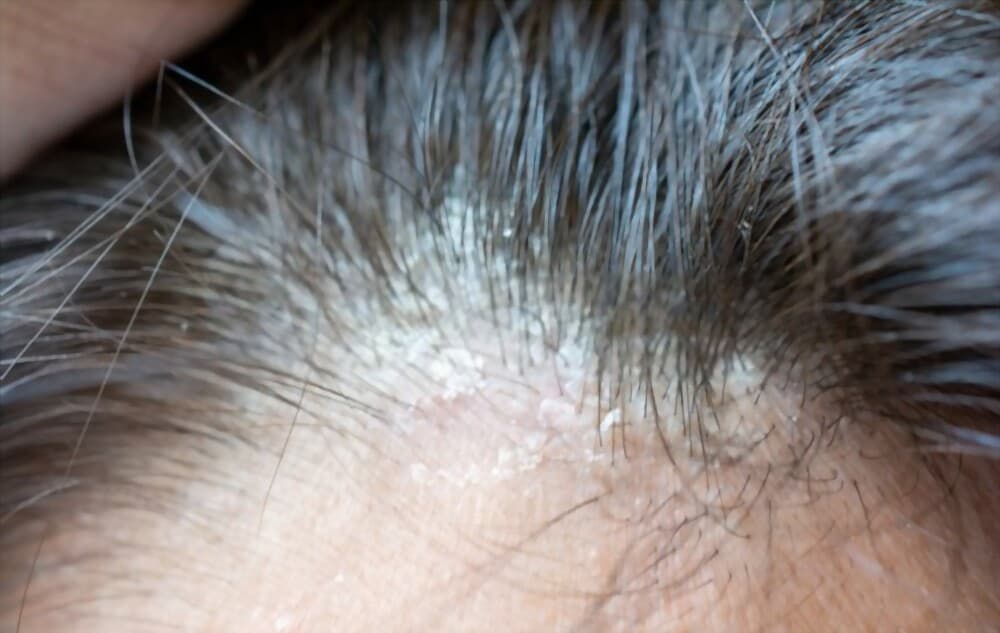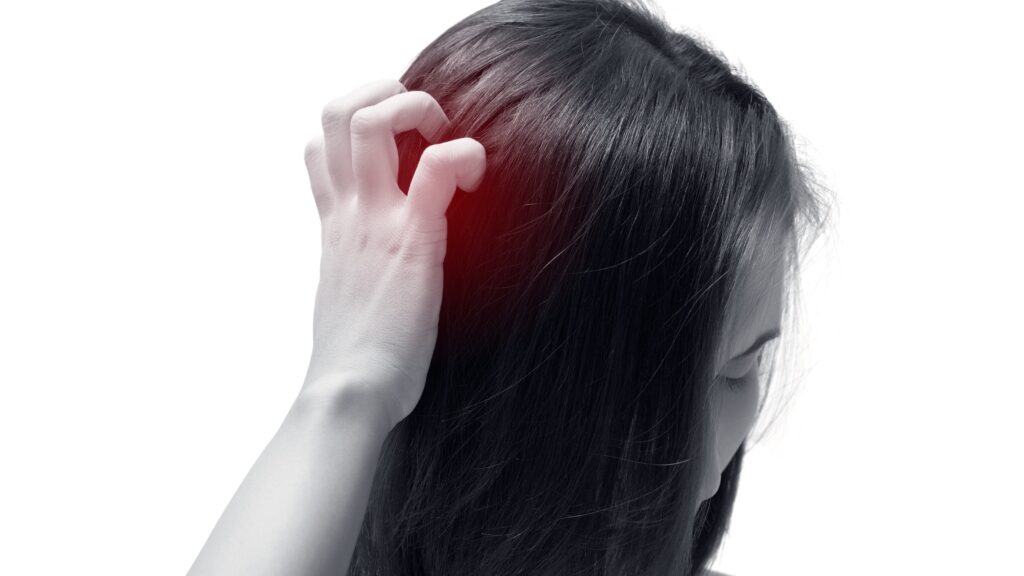Hair loss can be a very dreadful experience, affecting self-esteem and confidence. While there are many potential causes, one often overlooked factor is the health of your scalp. A healthy scalp is the foundation for strong, vibrant hair. Let’s explore how scalp problems might be causing your hair to fall off and what you can do about it.
Scalp-Hair Connection
- Your scalp is more than just the skin on your head; it’s a complex ecosystem that houses hair follicles, sebaceous glands, and a delicate balance of microorganisms.
- When this balance is disturbed, it can eventually lead to various scalp conditions that may contribute to hair loss.
Common Scalp Problems Leading to Hair Loss
Dandruff (Seborrheic Dermatitis)

- Dandruff is characterized by an itchy, flaky scalp. It’s caused by an overgrowth of yeast called Malassezia, which can lead to inflammation.
- This inflammation can weaken hair follicles, making hair more prone to falling out.
Scalp Psoriasis

- Psoriasis is an autoimmune disease that results in red, scratchy and scaly patches on the scalp.
- These patches can be itchy and scratching them can effect hair follicles, leading to hair loss.
Alopecia Areata

- This is an autoimmune condition where your body’s immune system attacks hair follicles, leading to hair fall in small, round patches.
Folliculitis

- Folliculitis is the condition of inflammation of hair follicles due to bacterial or fungal infections.
- It can cause red, pus-filled bumps that may results in scarring and permanent hair loss if left untreated.
Tinea Capitis (Ringworm of the Scalp)

- Tinea capitis is a fungal infection that results in scaly, bald patches.
- It is highly contagious and requires antifungal treatment to prevent permanent hair loss.
Excessive Oil Production (Seborrhea)

- Overactive sebaceous glands can produce too much oil, leading to clogged hair follicles and an environment that supports fungal growth.
- This can result in inflammation and weakened hair follicles.
Symptoms to Watch For
Persistent itchiness

Persistent itchiness of the scalp or hair can be quite bothersome and may have various causes. Here are a few common reasons:
- Dandruff: One of the most common causes of an itchy scalp is dandruff, which is caused by the overgrowth of yeast on the scalp. This can result in flaking and itching.
- Dry Scalp: Dry scalp can occur due to factors like cold weather, excessive washing with harsh shampoos, or certain skin conditions. It can cause itchiness and sometimes flaking.
- Product Buildup: Using too much hair care products or not rinsing them out properly can lead to buildup on the scalp, causing irritation and itching.
Redness or swelling
Redness or swelling around the hair follicles can be concerning and may indicate various underlying issues. Here are some potential causes:
- Folliculitis: This is a common condition where the hair follicles become inflamed, usually due to bacterial or fungal infection. It can result in redness, swelling, and sometimes pus-filled bumps around the hair follicles.
- Contact Dermatitis: If you’re allergic or sensitive to certain hair care products, chemicals, or dyes, they can cause an allergic reaction on the scalp, leading to redness, swelling, and itching.
- Ingrown Hairs: When hair curls back or grows sideways into the skin instead of upward, it can cause inflammation, leading to redness, swelling, and sometimes pain

Flaky or scaly patches

Flaky or scaly patches on the scalp can be indicative of various underlying issues. Here are some potential causes:
Dandruff: Dandruff is a common condition characterized by flaky, white or yellowish scales on the scalp. It’s often caused by the overgrowth of a yeast-like fungus called Malassezia. It can result in itching and sometimes redness of the scalp.
Seborrheic Dermatitis: This is a more severe form of dandruff characterized by red, itchy, and flaky patches on the scalp. It can extend beyond the scalp to other oily areas of the body, such as the face and chest.
Psoriasis: Psoriasis can affect the scalp, causing red, scaly patches covered with silvery scales. It can be itchy and sometimes painful.
Pus-filled bumps or blisters
Pus-filled bumps or blisters on the scalp can be indicative of various underlying issues, some of which may require medical attention. Here are some potential causes:
Folliculitis: This condition occurs when hair follicles become infected, often by bacteria such as Staphylococcus aureus or fungi. It can result in painful, pus-filled bumps on the scalp.
Impetigo: This highly contagious bacterial skin infection can occur on the scalp, especially in children. It leads to the formation of small, pus-filled blisters that can rupture and crust over.
Herpes Zoster (Shingles): Shingles is caused by the reactivation of the varicella-zoster virus, the same virus that causes chickenpox. It can affect the scalp and lead to painful, fluid-filled blisters that eventually crust over.

Unexplained hair thinning or bald patches

Unexplained hair thinning or bald patches can be distressing and may indicate various underlying issues. Here are some potential causes:
- Alopecia Areata: This is an autoimmune condition where the immune system mistakenly attacks hair follicles, leading to hair loss in patches. The cause of alopecia areata is not fully understood, but it’s thought to involve a combination of genetic and environmental factors.
- Telogen Effluvium: This is a condition characterized by temporary hair shedding due to a sudden shock or stress to the body, such as illness, surgery, childbirth, or severe emotional stress. It can lead to diffuse hair thinning rather than distinct bald patches.
- Androgenetic Alopecia: Also known as male-pattern or female-pattern baldness, this genetic condition causes gradual hair thinning and eventual baldness. In men, it typically starts with a receding hairline and thinning at the crown, while in women, it often leads to overall thinning of the hair.
If you notice any of these symptoms, it’s important to consult a dermatologist to determine the cause and appropriate treatment.
Preventing and Treating Scalp Problems
- Regular hair washing with a gentle shampoo can help keep the scalp clean and free from excessive oil and debris. Be gentle to avoid irritating the scalp.
- For conditions like dandruff or psoriasis, medicated shampoos containing ingredients like ketoconazole, salicylic acid, or coal tar can be beneficial.
- Limit the use of hair products containing harsh and unsafe chemicals, as they can irritate the scalp and exacerbate existing conditions.
- Enough hydration and a healthy diet rich in vitamins and minerals support overall scalp health. Foods containing high amount of omega-3 fatty acids, zinc, and biotin are particularly beneficial.
- Stress can exacerbate scalp conditions and hair loss. Practices such as meditation, yoga, or regular exercise can help manage stress levels.
- If over-the-counter treatments don’t work, seek advice from a dermatologist. They can provide tailored treatments, such as corticosteroids for inflammation or antifungals for infections.
Conclusion
Scalp problems are a common but often overlooked cause of hair loss. By understanding the link between scalp health and hair loss, you can take steps to maintain a healthy scalp and prevent further hair fall. Regular scalp care, appropriate treatments, and a healthy lifestyle are key to ensuring your hair remains thick and vibrant.
Remember, early intervention is crucial. If you’re experiencing persistent scalp issues or hair loss, don’t hesitate to seek professional help. Your hair and your confidence will love you and thank you.




